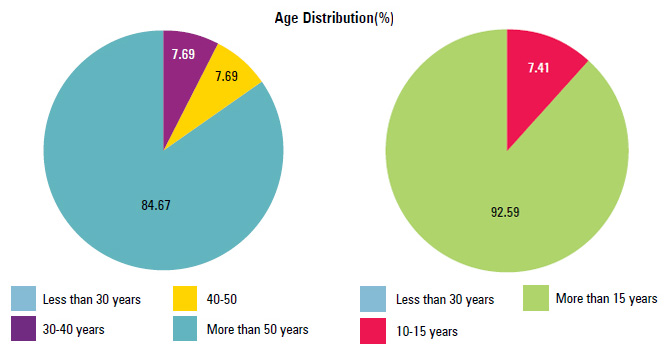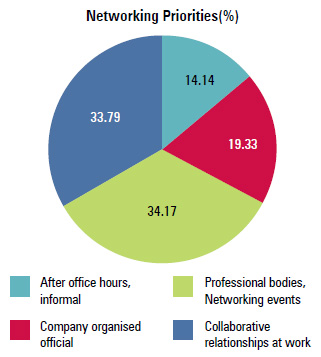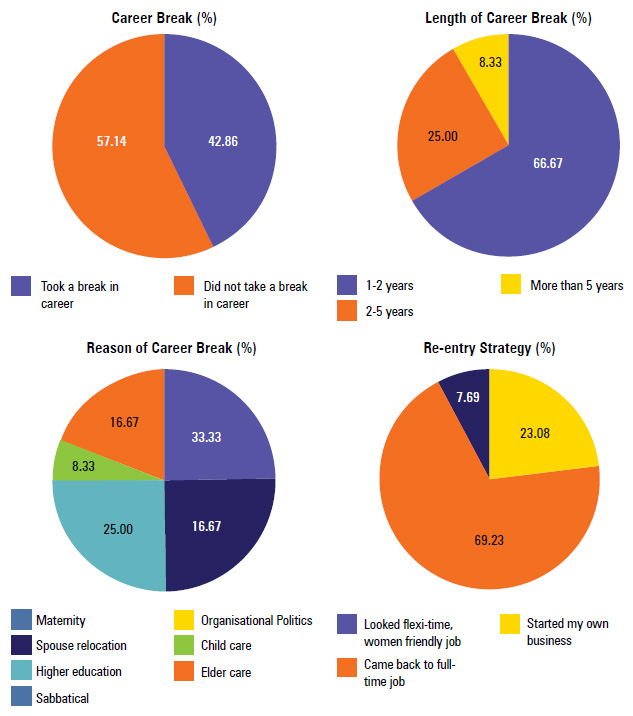Women leaders have shown their mettle in the industry by climbing the ladders of success, shattering the glass ceiling and proving that they are just as capable of heading organizations as their male counterparts. That being said, things are far from perfect, as women still have to address a host of challenges in the workplace. With a view to understand the unique challenges women face and the way they surmount them, CII has prepared the Success Strategies of Women Leaders report. Corporate Citizen brings you the results

This extensive research with around 50 C-suite women leaders helped CII discover a pattern around the strategic approach they followed in their course of success journey. A majority (84.62%) were above 50 years age and 92.59% with more than 15 years of work experience.
Networking Activities: Women leaders mostly acknowledged that they give a great deal of importance to networking activities in their everyday schedules. A rating of 7.79 out of a maximum of 10 was given in the sample on "Importance of networking". The most preferred modes of networking were participation in professional bodies and networking events (34.17%) and establishing collaborative relationships at work (33.79%).
Direct and Clear Communication: C-suite women demonstrate their authenticity with a strong preference for direct and clear communication and say it like it is, and sometimes make situational adjustments in tone and content of communication. A few avoid negativity and the least preferred style was to be indirect and use softeners and frequent smiles and nods.
Business Etiquette: Women leaders gave maximum importance to their reputation and image being cultivated through hard work and conscious effort. It is highly important too, to follow business etiquette and codes of professional conduct and to take care over dress and appearance. They do not much like to invest in expensive branded apparel and give low priority to presence on social media.
Glass Ceilings: All respondents acknowledged that that subtle forms of gender bias and cultural misogyny does exist, ignoring women and in a very imperceptible manner, inhibiting their growth. They acknowledged the presence of glass ceilings that prevent women from reaching the top.
Work-life Balance: Women strive to create work-life balance and help manage things with a network of family and paid help. The second priority for achieving work-life balance is to have flexible work-life options to provide time for family, work and leisure commitments. A large chunk of women have reported that they do not like to work late hours because it does not help with family commitments, and they always felt that they have given priority to family life at the cost of career.
Career Break: In keeping with global trends, 42.86% of women leaders have taken a career break, 33.33% for maternity and 25% for childcare, followed by 16.67% for spouse relocation and the same number for sabbatical. Eldercare (8.33%) was the second lowest reported reason for career break and 0% for educational reasons; 66.67% of the career breaks were for 1-2 years, 25% for 2-5 years and 8.33% for more than five years. Re-entry was largely for coming back to full time jobs (69.23%) and 23.08% look for flexi-time, women friendly jobs. Only 7.69% started their own business so they could be in charge of their time allocation.
Financial Independence: A huge majority of Women leaders (56.67%) reported that they plan their finances and financial futures independent of other members in the family. 38.71% took all financial decisions jointly with spouse/ father/partners, and only 6.45% contributed towards family earnings and allowed their money to be managed by the spouse/ father/partner.
Women leaders tend to adopt more transformational leadership styles and empower teams to take independent decisions or create democratic participative decision-making by consensus. They also liked to delegate activities and hold team members accountable. The least preferred leadership style was direct control and supervision, which is more transaction and control oriented.
Ninety per cent of women leaders give time towards working for the cause of other women by mentoring, coaching, and counselling to inspire those who need, and many initiatives taken by them to create women-friendly policies in their organizations.
"To be able to succeed in today's hyper-dynamic work places, build the network of professional and personal relationships based on trust, transparency and shared vision"
-Chandni Jafri, CEO, Mumbai Angels Network

The overall purpose of the survey was to have conversations with successful women leaders to understand the networking patterns and communication styles, how to strike a balance between professional and personal life, their ideas on image management, leadership styles and values they adopt. The survey also sought to understand how they dealt with gender based challenges that they encountered, and how they are inspired to work for the cause of contribution to the betterment of women co-workers.
In the search for women leaders who would have success stories to share, the following criteria were used:

A little more than 50 women leaders were interviewed or responded to a survey questionnaire. The women leaders’ demographics on age and experience indicate that leadership comes with a degree of maturity. A large chunk of women leaders (84.62%) are more than 50 years old and there are none who are less than 30 years of age. However, there are significant but small number of women (7.69%) between 30 to 40 years and an equal number between 40- 50 years.
“Try not to imitate the behavior of your male colleagues at work so as to gain acceptance. Be yourself unapologetically!"
-Veena Sharma, Senior Advisor, Alvarez & Marsal (A&M)


There are many perceptions that women do not network as much as men do, and it is well known that networking is the #1 unwritten rule of success in corporate life. Often it is stated that networking is harder for women than men. Many a times, women are told that they will not be successful unless they have a certain amount of networking in their professional circles.
Often, women are already juggling professional and personal responsibilities and usually, networking after office hours takes away time from personal commitments and upsets work-life balance too.
During the survey, they mostly acknowledged that they give a great deal of importance to networking activities in their everyday schedules. A rating of 7.79 out of a maximum of 10 was given in the sample.
A great deal (34.66%) of time was given to networking in professional bodies and networking events, with a close second of 33.57% spent on taking time out for creating collaborative relationships with colleagues at work. As expected, after office hours informal networking was the least priority for the Women Leaders.
It is sometimes said that open and transparent communication from women can help break down gendered perceptions and open new leadership opportunities for them. The research conversations with successful women leaders revealed that these women had the strongest preference for direct and clear communication and say it like it is. It is perceived as a mark of honest authenticity and helps in clarity of relationships and communications with others. The second preference was for making situational adjustments to the communication depending on the purpose and person with whom they are communicating. These situational adjustments create rapport and help establish emotional connect with the other.
The least preferred style was to be indirect and use softeners and frequent smiles and nods without coming directly to the point. Communication needs to be spontaneous and not always thought through before speaking. Avoiding negativity was also not a route to success as it inhibits authenticity.

"First, imbibe the cardinal principle that you are responsible for whatever happens in your corporate life. Don’t look for crutches or concessions”
-Kalpana Jaishankar, Chief HR Officer, Tata Consulting Engineers

Most people will agree that the work you will do will be the ultimate determinant of your success. However, knowing how to dress, behave, communicate and present yourself well will help you stand apart from the crowd and ante a positive impression. For a woman, a positive image is crucial for success as it complements her personality and multiplies her power of influence manifold. CII’s research questions delved deeper into women's perceptions about building a personal brand and an iconic style of dress, voice, mannerisms and appearance. Social media also plays a role in managing image and reputation. Women leaders gave the maximum importance to their reputation and image being cultivated through hard work and conscious effort. It is highly important too, to follow business etiquette and codes of professional conduct and to take care over dress and appearance. A significantly lower rating was given to investment in premium brands and expensive clothing as not seen as essential to a good image.
Discussing gender inequality and related challenges can be difficult in professional environment. Many women prefer to avoid this topic and not rock the boat. However, in times of #MeToo, every study undertaken supports the fact that women are still subject to bias in the workplace. These challenges are unique to women and generally not recognized by men. Perhaps for this reason, the survey results point to generally low ratings from women leaders for the various challenges they encountered as we wished to explore these with them.
The under representation of women in leadership roles is mute testimony to the fact that subtle forms of gender bias does exist, ignoring women and in a very imperceptible manner, inhibiting their growth. Women leaders have given complete recognition to this fact as the largest challenge encountered by them. Cultural misogyny is acknowledged to be the main challenge and the most difficult to counter
Six per cent of directorships, 4% of CEO Roles, and 4% of C-Suite roles go to women. Lower down the pyramid the representation of women can be as high as 30-40% although, almost 40% of urban workforce are women. The research reveals that the glass ceiling effect does exist and has been encountered by the women leaders.
Economic gender parity ensures that women are often paid less than men for the same jobs. World Economic Forum monitors country index on economic gender disparity. In India, many initiatives inform that we have closed 67% of the economic gender gap, but still dropped to 108 in 2017 from 87 in 2016.

"Stay focused, experiment in learning, build your unique skillset and do not indulge in gossip / politics to climb up the ladder”
Simi Thapar, Head -Equipment Leasing and Financing Solutions, Tata Capital

While the excitement of work, dreams and ambition can be a great motivator to succeed, the responsibilities of leading in business added to the responsibilities in personal life can be a great stressor.
It is apparent that a supporting structure that can help with childcare and elder care is an essential part of the success story. Women leaders have worked hard to create a network of family and paid help in the form of nannies, maids, day-care to support them in the balancing act. A top strategy to create work-life balance and help manage things.
The second priority for achieving work-life balance is to have flexibility to manage family, work and leisure commitments. Even at the top of the ladder, a balance of leisure and family is important. So, it’s not always about work alone.
It also helps if the spouse takes equal responsibility for the burden of multitasking and juggling the various roles and commitments needed. Attitudes of men who are partners to successful working women have recently changed.

“I think young working women should realize that each one has different priorities and should not try to imitate each other but should plan their own corporate life based on their own situation”
-Ketayun K Fallahzadeh, Group Head - Risk Management and Internal Audit, Tata Power Company Limited

Numerous studies have documented that, after investing in undergraduate and graduate studies and establishing careers, women are leaving their chosen professions at increasingly higher rates. The fact that work is more demanding and employees spend long hours at work in today's competitive environment makes it highly difficult for Indian women to have career continuity and they opt out when faced with family, children and social pressure.
For women, leaving a good Job may be particularly damaging to their career. Women leaving the workforce usually find it difficult to 'opt back in' at commensurate job levels. The barriers to re-entry further perpetuate and exacerbate gender inequalities. This was a crucial part of the conversations with women leaders where CII tried to map out the dynamics of taking career breaks and strategies for re-entry.
Women often take a break in their careers for different reasons. As much as 42.86% of the top management women executives had taken a break sometime during their careers.
There are two top drivers that forces women to leave the organization, maternity and childcare issues. These two factors have the most to contribute to the "opt-out" decision.
Delving deeper into the reasons for the career break, of the 42.86% women, 33.33% had taken it for maternity reasons and 25% for childcare. The role of being a mother is compelling indeed.
Other reasons for career break are spouse relocation (16.67%) and sabbatical (16.67%). A small but significant percentage (8.33%) was for elder care.
Dreams, ambition and passion are hard to put off for an extended period of time. The need to return back to career is sometimes urgent.
At the Confederation of Indian Industries (CII)’s 3rd WomeNation held recently, its Western Region chapter undertook a research on success strategies deployed by successful women leaders. An overview by
Dr Aneeta Madhok, Vice Chairperson, CII IWN Maharashtra Chapter, and Managing Director, Open Space Consulting Ltd (the knowledge partners in this survey) on the overview and details of the survey.
 From Left to Right: Dr Aneeta Madhok, Kashmira Mewawala, Vibha Padalkar, Renu Basu, Pallavi Jha, Ninad Karpe,
Richa Arora and Ipsita Dasgupta
From Left to Right: Dr Aneeta Madhok, Kashmira Mewawala, Vibha Padalkar, Renu Basu, Pallavi Jha, Ninad Karpe,
Richa Arora and Ipsita DasguptaIt’s not often that we get to see the positive side of things and celebrate success and recognize the hard work it took to get there. It’s especially rare to have a compilation of these success stories from women leaders, first hand. It’s even rarer to have a compilation of these success stories and analyzed scientifically to map the strategies and practices adopted by the women in their endeavor to realize their dreams and ambitions. For women leaders it is particularly difficult as there are so many challenges along the way posed by both the corporate world where the majority are men as well as society and culture that has so far not encouraged them to succeed in business and career.
For me, it was an inspirational project because in many of the stories we heard, I also found similar echoes in my life and work. It’s only when the stories are shared, we realize that we are not alone. The thought is empowering indeed. I hope with this work, there is a small step taken towards inspiring other women on the success path to find that their individual actions can create a wave of change I keeping with the trends we find here.
"For me, it was an inspirational project because, I found similar echoes in my life and work. It’s only when the stories are shared, we realize that we are not alone"
Dr Aneeta Madhok

I researched a lot to understand a document, and create an inspirational storyline, in the strategies that women require in the pursuit of their dreams and achievements, and they did it. How we did it-we had dialogues and conversations centered around the theme; we had nine themes in all, where we captured qualitative as well as quantitative data against the survey questionnaire and the sample consisted of women leaders in the corporate and business world. It was intentionally drawn, as we had to brainstorm and seek them out, seek their support. The sample also consisted of a few women entrepreneurs with a proven track record. Let’s just say that 93 per cent of our sample had more than 15 years of work experience. You see, success doesn’t come instantly. It takes time to get to the sweet spot.
"Over the years we have heard that one of the hurdles that hold women back from realizing their potential is the lack of authentic role models they can relate to. This project is an appropriate vehicle to carry the inspirational stories"
– Kashmira Mewawala

We had nine themes in all:
At CII IWN, we hear unique, fascinating narratives of women succeeding in the corporate/business sector, but not all make it to the headlines. It was felt that sharing accounts of successful women from varied streams of corporate and business with a larger audience would inspire emulation. It would also help us to celebrate the women who surmounted impediments, smoothened their journeys, and laid the path for more women to tread and achieve professional success.
Over the years we have heard that one of the hurdles that hold women back from realizing their potential is the lack of authentic role models they can relate to. In my view, this project is an appropriate vehicle to carry the absorbing and inspirational stories and the voices of successful women to an audience that can benefit from them. Many of the accounts are from women who have not just transformed their own lives, but also assisted their colleagues, employees and even communities along the way.
By Neeraj Varty